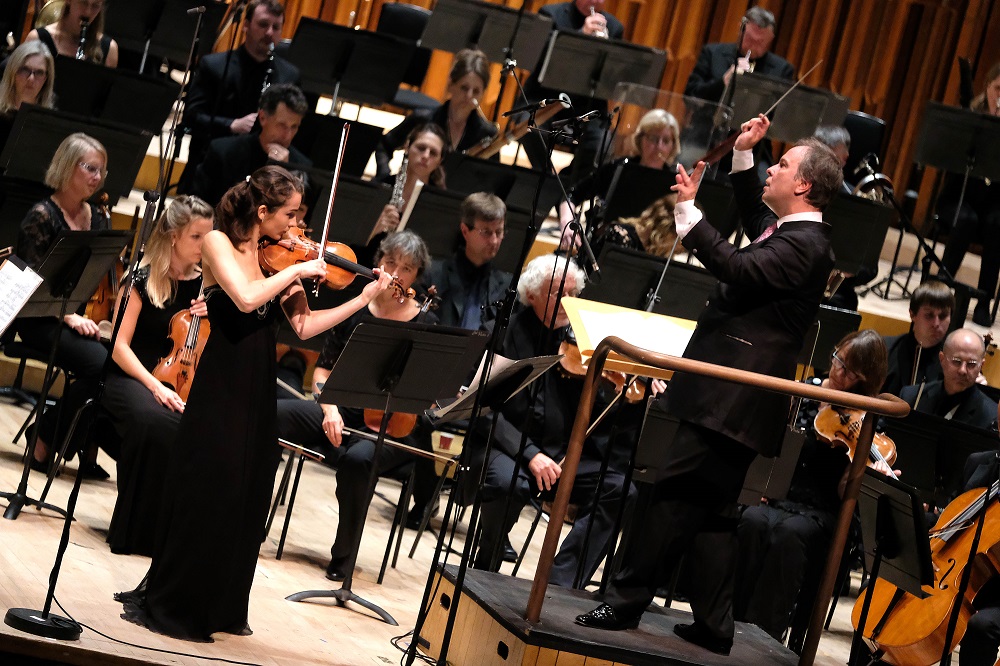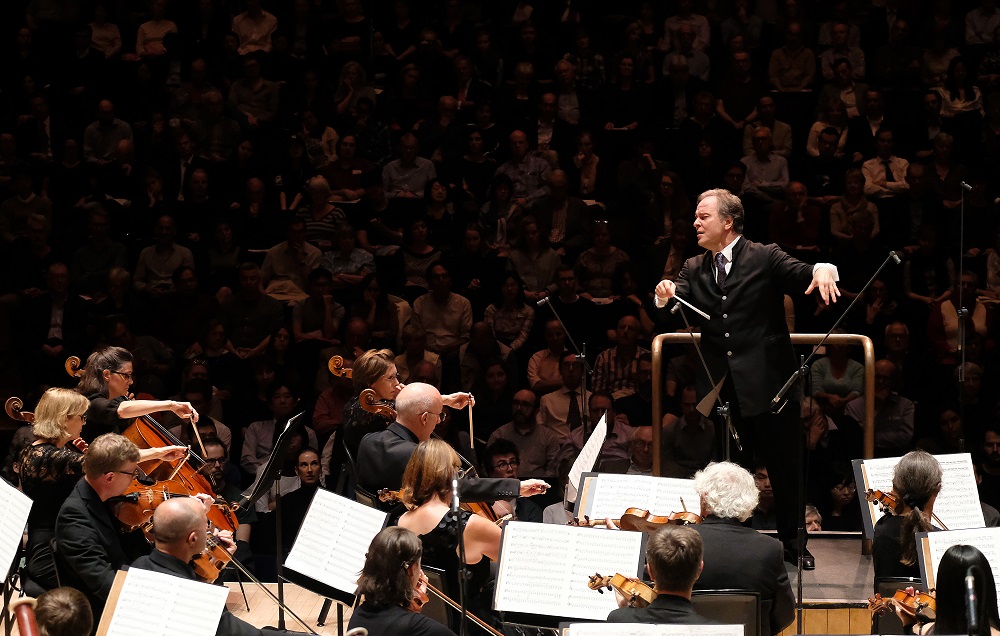Pogostkina, BBCSO, Oramo, Barbican review - human emotions in Sibelius's heaven | reviews, news & interviews
Pogostkina, BBCSO, Oramo, Barbican review - human emotions in Sibelius's heaven
Pogostkina, BBCSO, Oramo, Barbican review - human emotions in Sibelius's heaven
Death transcended, and a blaze of light and love in a great symphony
It was on the strength of a single concert including a startling Sibelius Luonnotar and Third Symphony, thankfully reported here, that Sakari Oramo was appointed Chief Conductor of the BBC Symphony Orchestra.
Constant Lambert, writing in his pithy survey of music up to 1932 Music Ho!, saw Sibelius – who by then had more or less ceased to compose – as the one light in semi-darkness, the only way forward. The symphonies remain a deep testing-ground for any interpreter, and personally I can’t hear them too often; hearing Rouvali, then Oramo and next Esa-Pekka Salonen in succession can only be cause for excitement, for hearing new things in these fathomless works. While Lambert was wrong about what he thought was the ephemeral nature of Stravinsky’s neo-everything, borrowing from the past with huge individuality, he was spot on about how Schoenberg’s dodecaphony, his rigid system built on the 12 notes of the chromatic scale, would pass. It took a long time, but now it’s turned out to be only one movement among many. Berg still seems the one figure who truly humanised it, and to hear his Violin Concerto of 1934 between Strauss’s Death and Transfiguration and Sibelius’s Fifth last night proved enlightening.

Not, it has to be said, in the expected way. Most violinists play it as a desperate struggle against death, taking their cue from the putative dedication to the daughter of Alma Mahler and Walter Gropius, Manon, who died suddenly at the age of 18. Subsequent scholarship suggests that the “angel” of its dedication could have been Hanna Fuchs-Robettin, the woman Berg described as his “one and only eternal love”. How, then, to account for the consolation of Bach’s chorale “Es ist genug” (“It is enough”) towards the end of the work? For Alina Pogostkina (pictured above with Oramo and the orchestra), this was pure abstraction – not without emotion, but smilingly in focus throughout. If that deprived the chorale, beautifully led by the BBCSO clarinets, of its potential catharsis and kept tears very much at bay, it was a refreshing take, fine-tuned and very much part of the orchestral textures Oramo revealed so tellingly; sometimes brass solos, muted or otherwise, took pride of place over the violin. Unnatural, perhaps, for a violinist not to have broken any apparent sweat over the work, but worth hearing it this way, with ears refreshed, once in a lifetime.
The first half of two very different struggles with death began with Strauss’s more callow imagining, as a relatively young man, of how it might be. The sick-room opening, with flautist Daniel and guest oboist Emily Pailthorpe poetically joining hands, was exquisitely done, the pain and the memories focused with typical Oramo drive; but this afterlife felt a little perfunctory – a special light needs shining on Strauss’s straightforward material here. More space in the pacing and the acoustic might have pulled it off.
The new LSO partnership actually has its equal hereUp in Sibelius’s plains of heaven, though, not a foot or a note went awry, even if the surprisingly passionate feelings outlined so strikingly from woodwind, first trumpet and violins – led last night by the vivacious Maya Iwabuchi – showed us a very human attempt to negotiate unknown territory. Those amazing string scythings on the way to a peak which, amazingly, Sibelius only found in the revised versions of what was originally a four-movement symphony, made the hair stand on end; once reached, the violins rose up ecstatically against the fanfares before dropping back to quiet neutral so that the whole process could begin again, ever faster.
Oramo is a master at the oscillations of two unusual middle movements – the one in the Third as much as this Andante mosso, quasi allegretto – and highlights the drama that unexpectedly erupts. Striking, indeed, the suspension of a string chord before the movement’s cheerful resolution. Then straight on to perhaps the most glorious of all symphonic finales, bringing an onrush of deep emotion as the horns began their swinging motif, intensified with the added quirk of the woodwind's swan-cries in the last slow burn. Oramo’s flexibility in tempi, even when it brought some surprising extremes, seemed absolutely right; and with the upper strings returning to the movement's opening buzz in extreme pianissimo, we had our parallel with Rattle’s Firebird trick the previous week. A reminder that the new LSO partnership actually has its equal here, in unquestionably the most viscerally exciting Sibelius Five I’ve heard and a relationship in which all the players, uniquely, seem to love their Chief Conductor.
The future of Arts Journalism
You can stop theartsdesk.com closing!
We urgently need financing to survive. Our fundraising drive has thus far raised £49,000 but we need to reach £100,000 or we will be forced to close. Please contribute here: https://gofund.me/c3f6033d
And if you can forward this information to anyone who might assist, we’d be grateful.

Subscribe to theartsdesk.com
Thank you for continuing to read our work on theartsdesk.com. For unlimited access to every article in its entirety, including our archive of more than 15,000 pieces, we're asking for £5 per month or £40 per year. We feel it's a very good deal, and hope you do too.
To take a subscription now simply click here.
And if you're looking for that extra gift for a friend or family member, why not treat them to a theartsdesk.com gift subscription?
more Classical music
 Hallé John Adams festival, Bridgewater Hall / RNCM, Manchester review - standing ovations for today's music
From 1980 to 2025 with the West Coast’s pied piper and his eager following
Hallé John Adams festival, Bridgewater Hall / RNCM, Manchester review - standing ovations for today's music
From 1980 to 2025 with the West Coast’s pied piper and his eager following
 Kaploukhii, Greenwich Chamber Orchestra, Cutts, St James's Piccadilly review - promising young pianist
A robust and assertive Beethoven concerto suggests a player to follow
Kaploukhii, Greenwich Chamber Orchestra, Cutts, St James's Piccadilly review - promising young pianist
A robust and assertive Beethoven concerto suggests a player to follow
 Robin Holloway: Music's Odyssey review - lessons in composition
Broad and idiosyncratic survey of classical music is insightful but slightly indigestible
Robin Holloway: Music's Odyssey review - lessons in composition
Broad and idiosyncratic survey of classical music is insightful but slightly indigestible
 Classical CDs: Wolf-pelts, clowns and social realism
British ballet scores, 19th century cello works and contemporary piano etudes
Classical CDs: Wolf-pelts, clowns and social realism
British ballet scores, 19th century cello works and contemporary piano etudes
 Bizet in 150th anniversary year: rich and rare French offerings from Palazzetto Bru Zane
Specialists in French romantic music unveil a treasure trove both live and on disc
Bizet in 150th anniversary year: rich and rare French offerings from Palazzetto Bru Zane
Specialists in French romantic music unveil a treasure trove both live and on disc
 Scottish Chamber Orchestra, Ibragimova, Queen’s Hall, Edinburgh review - rarities, novelties and drumrolls
A pity the SCO didn't pick a better showcase for a shining guest artist
Scottish Chamber Orchestra, Ibragimova, Queen’s Hall, Edinburgh review - rarities, novelties and drumrolls
A pity the SCO didn't pick a better showcase for a shining guest artist
 Kilsby, Parkes, Sinfonia of London, Wilson, Barbican review - string things zing and sing in expert hands
British masterpieces for strings plus other-worldly tenor and horn - and a muscular rarity
Kilsby, Parkes, Sinfonia of London, Wilson, Barbican review - string things zing and sing in expert hands
British masterpieces for strings plus other-worldly tenor and horn - and a muscular rarity
 From Historical to Hip-Hop, Classically Black Music Festival, Kings Place review - a cluster of impressive stars for the future
From quasi-Mozartian elegance to the gritty humour of a kitchen inspection
From Historical to Hip-Hop, Classically Black Music Festival, Kings Place review - a cluster of impressive stars for the future
From quasi-Mozartian elegance to the gritty humour of a kitchen inspection
 Shibe, LSO, Adès, Barbican review - gaudy and glorious new music alongside serene Sibelius
Adès’s passion makes persuasive case for the music he loves, both new and old
Shibe, LSO, Adès, Barbican review - gaudy and glorious new music alongside serene Sibelius
Adès’s passion makes persuasive case for the music he loves, both new and old
 Anja Mittermüller, Richard Fu, Wigmore Hall review - a glorious hall debut
The Austrian mezzo shines - at the age of 22
Anja Mittermüller, Richard Fu, Wigmore Hall review - a glorious hall debut
The Austrian mezzo shines - at the age of 22
 First Person: clarinettist Oliver Pashley on the new horizons of The Hermes Experiment's latest album
Compositions by members of this unusual quartet feature for the first time
First Person: clarinettist Oliver Pashley on the new horizons of The Hermes Experiment's latest album
Compositions by members of this unusual quartet feature for the first time


Add comment